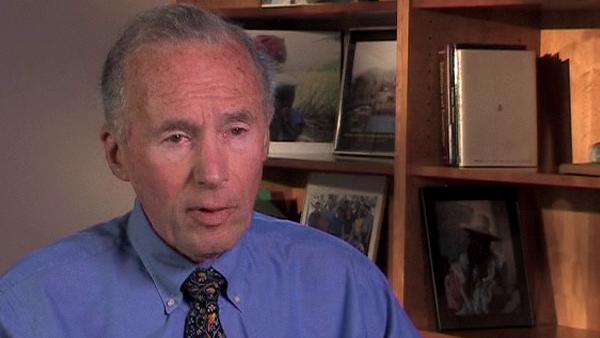NEXT STORY

Sidewalk seminars
RELATED STORIES

NEXT STORY

Sidewalk seminars
RELATED STORIES


|
Views | Duration | |
|---|---|---|---|
| 1. Talking to Web of Stories | 762 | 02:01 | |
| 2. Family peregrination ends in the USA | 350 | 03:31 | |
| 3. Why I became a doctor | 321 | 02:02 | |
| 4. Accepted by Harvard to major in English | 164 | 02:35 | |
| 5. My early medical career | 144 | 04:15 | |
| 6. My wife: the most important person in my life | 277 | 01:40 | |
| 7. Discovering the beauties of science | 114 | 03:28 | |
| 8. Sidewalk seminars | 70 | 01:33 | |
| 9. Crash course in oncology | 113 | 03:00 | |
| 10. Researching ribose metabolism | 67 | 02:03 |

From the New York Hospital, I went to the National Institutes of Health in Bethesda. New York Hospital was noteworthy for us for an important reason. It was where our daughter, Deborah, was born so when we left for Bethesda we had two children, John and, and Deborah, and before we left Bethesda our third child, our second son, Fred, was born. I arrived at the... when I arrived at the NIH, the clinical center still had not been finished. There had been a strike and the fact that it wasn't completed turned out to be one of the most important issues of my life. A friend had sent me to meet a biochemist at the NIH named Bernie Horecker, and because it wasn't possible to begin work in the clinical center I asked Bernie whether he'd have space in his laboratory. He... he told me that his colleague, Arthur Kornberg, had recently left to go to St Louis to Washington University and that he'd have laboratory space. The name Kornberg meant no more to me, at that time, than the name Horecker, and I wasn't above being willing to work in space that Kornberg had... had vacated.
At this time Horecker was working on elucidating the pathway of pentose phosphate metabolism, and that, again, was something completely unfamiliar to me. Bernie said to me, we're now in the process of purifying spinach transketolase. I had no experience with transketolase, some experience with spinach. It seemed like something quite remote from anything that really would ever have any meaning to me, but I joined that project and it was really a stunning experience. Bernie Horecker opened my eyes to what biochemical science can be, opened my eyes to what experimentation can mean, opened my eyes to the... the beauties of science.
Born in 1925, American Howard Hiatt set up one of the first medical oncology research and training units in the US and has headed up some of America's most prestigious medical institutions. Hiatt attended Harvard College and received his MD from the Harvard Medical School in 1948. He was a member of the team at the Pasteur Institute, Paris, that first identified and described mRNA, and he was among the first to demonstrate mRNA in mammalian cells. From 1991 to 1997, he was Secretary of the American Academy of Arts and Sciences, where he began and directs the Academy's Initiatives For Children program. He is also committed to helping disadvantaged people access decent health care.
Title: Discovering the beauties of science
Listeners: Milton C. Weinstein
Milton C. Weinstein, Ph.D., is the Henry J. Kaiser Professor of Health Policy and Management at the Harvard School of Public Health and Professor of Medicine at the Harvard Medical School. At the Harvard School of Public Health he is Academic Director of the Program in Health Decision Science, and Director of the Program on Economic Evaluation of Medical Technology . He is best known for his research on cost-effectiveness of medical practices and for developing methods of economic evaluation and decision analysis in health care. He is a co-developer of the CEPAC (Cost-Effectiveness of Preventing AIDS Complications) computer simulation model, and has conducted studies on prevention and treatment of HIV infections. He is the co-developer of the Coronary Heart Disease Policy Model, which has been used to evaluate the cost-effectiveness of cardiovascular prevention and treatment. He is an author of four books: Decision Making in Health and Medicine: Integrating Evidence and Values; Cost-Effectiveness in Health and Medicine,the report of the Panel of Cost Effectiveness in Health and Medicine; Clinical Decision Analysis; and Hypertension: A Policy Perspective.He has also published more than 200 papers in peer-reviewed medical, public health, and economics journals. He is an elected member of the Institute of Medicine of the National Academy of Sciences, and a recipient of the Award for Career Achievement from the Society for Medical Decision Making. Dr. Weinstein received his A.B. and A.M. in Applied Mathematics (1970), his M.P.P. (1972), and his Ph.D. in Public Policy (1973) from Harvard University.
Tags: National Institutes of Health, Bernard Horecker, Arthur Kornberg
Duration: 3 minutes, 28 seconds
Date story recorded: September 2006
Date story went live: 24 January 2008